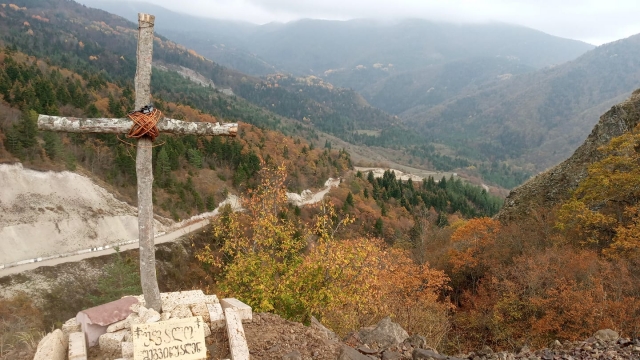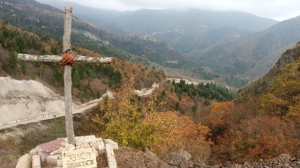A Little-Known Gorge You Have to See
BLOG
The Dzama Gorge (dzamis kheoba) near Kareli in central Georgia, some 130km from Tbilisi, is a gem of religious and natural diversity: ice-cold river, rolling hills, rocky mountain slopes, woodland, and fields and gardens of apples and vines: perfect for a day or weekend trip out of town!
We chose to visit on a late autumn day, aiming to capture the last of the bright autumn colors. Sadly, we were late for most of the reds, but the yellow leaves were almost blinding in their intensity as they clung to the trees, battling the weight of the rain and the tug of the wind.
As it was a wet day, and we’d got to Kareli later than planned, we settled on three key destinations, earmarking the other 47 monasteries and the beautiful hidden Bateti Lake for spring and better weather.
We took a local taxi from Kareli center, agreeing on 35 GEL for a two-hour round-trip, which included waiting for us as we explored.
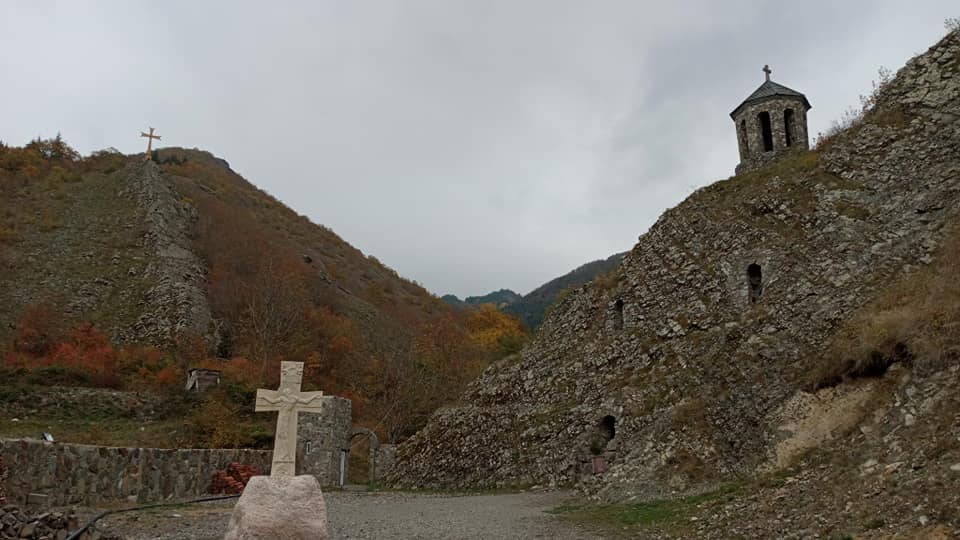
First stop was Sarkineti Church and Monastery, a fusion of modern and traditional construction and décor. The walled monastery beside the road is closed to the public (though the sign, in Georgian, was not clear, so we didn’t learn about this forbidden entrance until we were nearly through the flower garden and out the other side!) Never mind: it was the church we’d come to see, the only one of its kind in Georgia, carved into the gray rock in 2008 and opened and blessed in 2011. The Church of Shio Cave in Sarkineti is the first to have been built in a rock cave since the 14th century, with only an arched bell-tower, door and windows showing to hint at its sacred purpose. The temple can be reached through a 5-meter corridor, and once inside, you’ll be stunned by the gold-leaf floor-to-ceiling frescos reflecting the candlelight off of every wall.
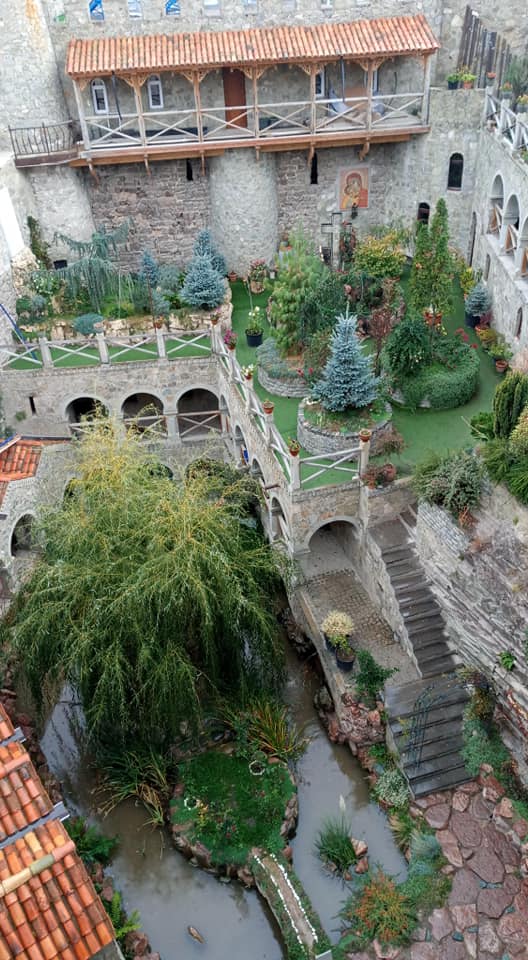
Next on our tour was Mzovreti Monastery, a strictly-run monastery complex built on what was once Tsitsishvili (or Mzovreti) Fortress. It’s a work-in-progress, and on arriving (taken up the steep and treacherous mud-track by jeep from the entrance building below), we were greeted by stone-masons and male construction workers focused on both the new exterior church and the interior gardens. We were also greeted by several large (but apparently friendly) dogs and a young bearded and hooded monk, one of five who live here, who kept his disapproval at my skirt length to himself but pointedly handed me a wrap-around before we went inside (my bad!).
Up the curving stone steps of the 17th-century seven-floor cobblestone tower, we followed him first into the mid-level garden, above it the wooden balcony and sleeping quarters of the residents. The stone covered by astro-turf and raised flowerbeds made for a colorful and calming atmosphere of secret-garden-like wonder: a very zen kind of place you just want to sit in and absorb.
We headed up to the 17th century restored church perched on the highest wall of the fortress, above the newly terracotta-tiled roof, and along a parapet. The 360-degree views were stunning, not at all marred by the clouds or drizzle, while the view down into the garden, a pond at the lowest level, were truly awe-inspiring. Inside, we saw the church walls are rough-hewn, as yet unpainted, and with the surprising (unorthodox) addition of two stained-glass windows depicting angels. The bells had also yet to be set in their permanent homes in the three-story late-18th century cobblestone bell tower. The bell tower, in its days as part of the fortress, was used as the guard's residence.
A bit of history: The construction of the Mzovreti Fortress is said to have been directly related to the relocation of the Tsitsishvili feudal center from Mtskheta to Mzovreti at the beginning of the 17th century.
Mzovreti “city” was located on the road connecting Shida, Kvemo and Zemo Kartli. In the 10th century, it was the residence of Prince Adranase, who was later followed by the Panaskertel-Tsitsishvilis, who moved their residence from Samtsevri here and turned Mzovreti into a political center for the nobility. After the 18th century, the city declined in size and status, and in the 19th century, the Tsitsishvilis left and the city ceased to exist. A new village, Ortubani, was built on its ruins.
The fortress of Mzovreti was consecrated as a monastery named after the Assyrian Fathers with the blessing of Reverend Job on May 20, 2008.
With the temperature dropping and only two hours till dark, we jumped back in our taxi and zipped off along and up a very well asphalted road to the most popular destination in the Dzama Gorge: the 12-13th century Kintsvisi Monastery.
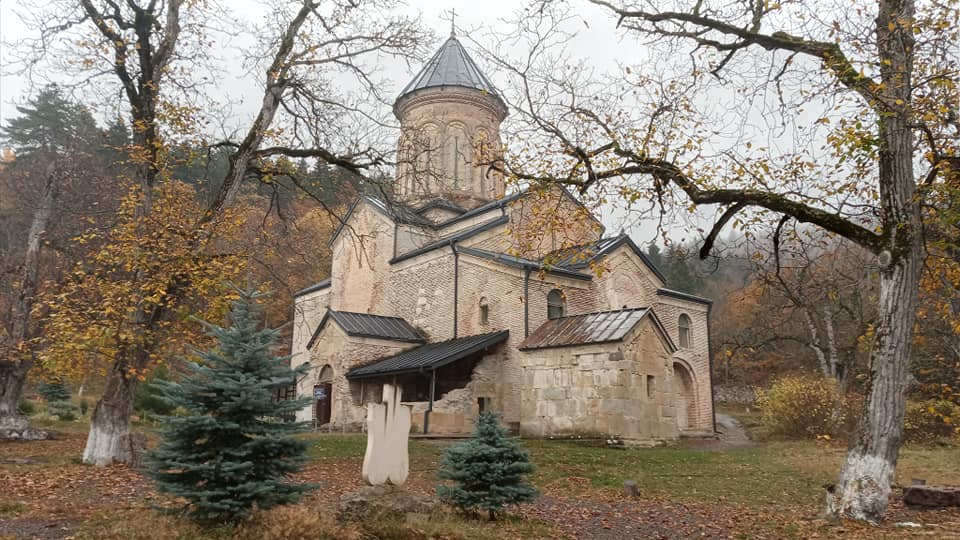
Easy to access via a quick walk through a wooded area (when we were there, carpeted with golden leaves), the complex includes the Church of St. Nicholas, the St. Virgin Mary, the ruins of the Church of St. John the Baptist, the Little Church, and the newly built small Church of St. Shio Mgvimeli on the left of the entrance. The main church is distinguished for its frescos, which, although damaged, certainly inspire a sense of wonder, appreciation and respect. The four favorites are the frescos of King George III, Queen Tamar, Lasha-Giorgi, and “The Kintsvisi Angel,” here depicted in the Resurrection scene and said by many to be “ahead of the achievements of the Italian Sienese Art School of the Renaissance times.”
We took time to walk around the church and garden, drink some holy water, admire the buildings in and out, and breathe the unbeatable fresh woodland air. Then it was back to civilization again, with the promise of a return trip in the near future!
By Katie Ruth Davies
